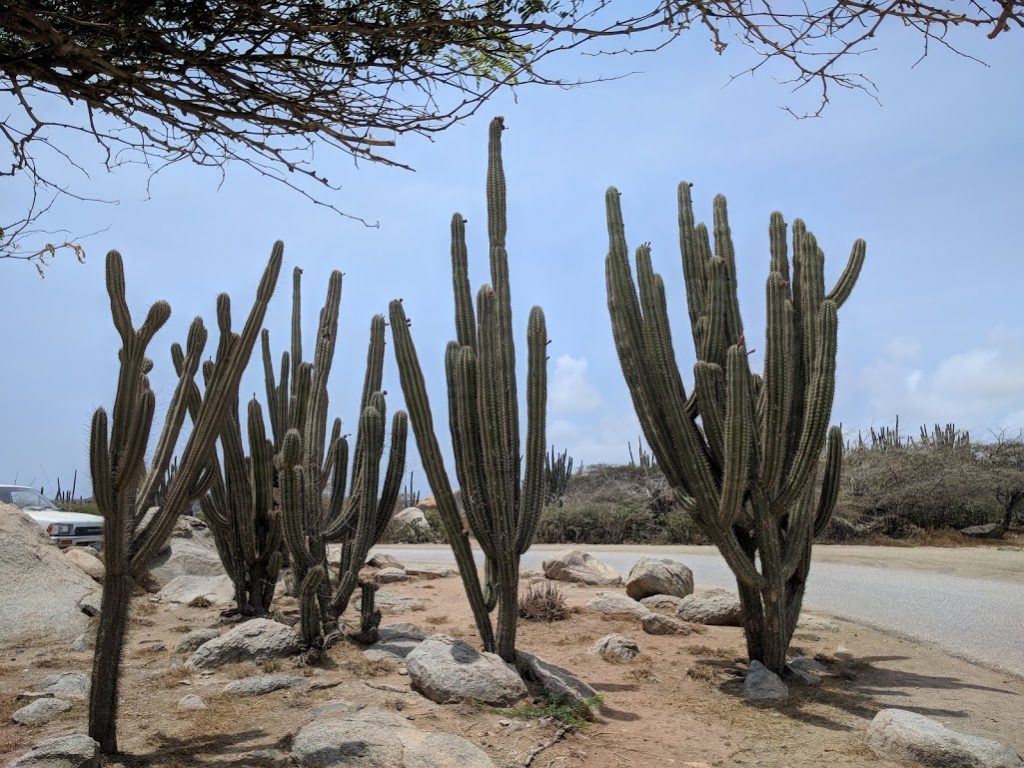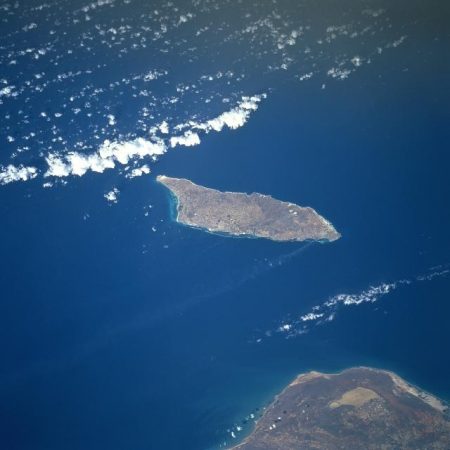May 7, 2018 – My wife and I had never been to Aruba. We booked an all-inclusive resort for a week there because the endless winter was making us depressed back here in Canada. Aruba turned out to be a brilliant decision. The weather was gorgeous (it rained for 30 minutes one day). The sun only occasionally was obscured by high clouds. And the wind never relented and therefore it is no wonder that Aruba is described as being one of the Windward Islands. The national tree, the Divi, is permanently bent by the wind.
Aruba is a little more than 12 degrees north of the equator, sitting very close to Venezuela. The geology like many Caribbean islands is a mix of coral, limestone, and volcanic rocks. The only significant geographic feature is a hill that sits in the centre of the island known locally as The Haystack. It stands 188 meters (a little over 600 feet tall) and looks like a farmer’s haystack. Other than the Divi trees, the most prominent vegetation are a variety of cacti. The soil is largely unsuitable for farming. The only crop I saw being grown was aloe vera. Fruit and vegetables unless grown in containers are all imported. There are no rivers on the island. The Caribbean Sea is the freshwater source used by islanders and visitors through the use of desalination technology.
There are 115,000 living on the island, not counting tourists (over 1.7 million per year). The biggest industry is tourism, followed by petroleum refining and bunkering, and banking. The two major cities constitute 41.7% of the population with Oranjestad, the capital, a home for more than 30,000.
When we took a bus tour of the island I asked our driver how many vehicles were on Aruba’s roads. He told me over 70,000. That means almost 70% of the population have motor transport powered by gasoline and diesel.
When our vacation ended we could only say good things about our visit to the island. Friendly people. Great service. A pleasant vacation climate.
But I couldn’t help going back to the climate conditions I observed, and the vehicles on the road. How could such a small island with perfect conditions for wind and solar power not be 100% clean energy already? And how could there not be electric buses and electric vehicles (EVs) on the hundreds of kilometers of roads? Where were the wind turbines and solar panels? Garbage was being openly incinerated in the outer harbour of Oranjestad. We experienced that first hand when a boat we were on ran through a plume of stinky carbon particulate matter on our way to a submarine ride.
To me, all the free energy capacity available to Aruba from solar and wind was going to waste while the island bore the burden of importing heavy oil from Venezuela for refining and for use in power plants, boats and ships, and ground vehicles.
Some places are perfect fits for renewable energy. This is one of them. Its climate is classified as semi-arid which means rain falls for about two months a year. The rest of the time we are talking about mostly sunny (except at night). And the wind never stops.

The investment in desalination is absolutely vital to the survival of the island’s population. A recent desalination plant upgrade uses reverse osmosis as the process to extract freshwater from coastal saltwater wells. Reverse osmosis is less energy intensive and less carbon polluting than older desalination technology still in use which heats seawater to extract steam condensate. But in both cases, desalination is consuming energy generated by thermal power plants burning highly-polluting heavy oil. These thermal plants are also the source of Aruba’s electricity. Add the 70,000+ cars, trucks, and buses on the roads and for such a small place you have a fairly significant carbon footprint yielding a 1,000,000 Metric tons of pollution annually.
Solar and wind plus EVs would almost wipe out the 1,000,000 tons. That appears to be the government’s ultimate intention. Since 2012 Aruba has committed to achieving 100% clean electricity by 2020. But, to date, I saw little evidence of a transition which is supposed to be ongoing and completed in a little over two years. Plans include an airport solar park, a waste-to-energy plant, and plans for multiple wind farms. The government hopes to introduce microgrid technology to seamlessly integrate solar and wind within the island’s existing energy infrastructure. The government is talking about making its tourist destinations more walkable and accessible. Maybe they have in mind something like the electric-powered tram that runs through downtown Oranjestad, a form of transportation that could be extended to much of the rest of the island. As of yet, there is little mention of converting remaining transportation choices such as tourist buses, cars, and trucks, to electric, from diesel and gasoline. And nor is there any mention of making desalination 100% renewable.
Now that I have experienced Aruba I intend to pay more attention to how well the island succeeds in achieving its 100% clean energy target and hope to report on its successes over the next few years.
And finally, if you have never been, both my wife and I highly recommend a visit to this unique island. The fences made from cactus alone are worth seeing. It is our intention to go back in a couple of years.
A note of caution, for an authentic Caribbean experience, try to stay away from the big hotels on Palm Beach that have the feel of Miami and lack the charm and intimacy of low-rise beach resorts.


















